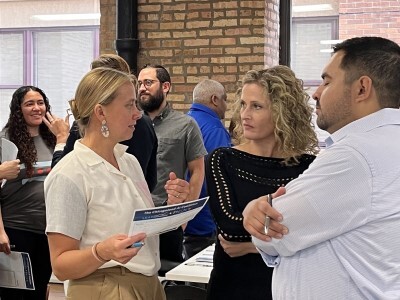Technology Tools
A ‘Spark’ of Innovation at Merit Prep
Topics

Educators often take advantage of educational technologies as they make the shifts in instruction, teacher roles, and learning experiences that next gen learning requires. Technology should not lead the design of learning, but when educators use it to personalize and enrich learning, it has the potential to accelerate mastery of critical content and skills by all students.
In an effort to put everything digital in one place for its students, teachers, parents, and administrators, Merit Prep is taking a collaborative approach to developing its next-gen tool, Spark 2.0
Editor’s Note: The spirit of iteration in innovation is alive and well at Merit Prep. Just this past September, Merit Prep, a Newark, NJ charter school operated by Matchbook Learning, launched Spark, a data integration tool created in-house. (See Next Gen Tools: Matchbook Learning’s “Spark” to learn more.) With the arrival of 2015, the pioneering team at Merit Prep kicked off the development of Spark 2.0. Matchbook Learning’s chief technology officer Al Motley shared the following overview of the new effort in a conversation with NGLC staffer Kristen Vogt.
What is Spark?
The original Spark 1.0 is one tool—a competency-based view of learning from all different data points, organized by Common Core standards. We have seven or eight additional tools that we created at Matchbook Learning, but they are segmented and fragmented. We are rebuilding all of the tools so that it’s all in one place for students, teachers, parents, and administrators, which we are affectionately calling “Spark 2.0”. It will be an ecosystem that the students and teachers live in every day and how they experience the Matchbook Learning model.
How are we building Spark?
We are not developing Spark 2.0 by fitting modules together; we are building it based on user experience. We will be exploring with teachers and students how much time they spend in Spark and other tools, how they tie information from the different tools together, how the different tech tools help them with teaching and learning. Just like Google has e-mail, calendar, and drive that do different things but all work together, Spark 2.0 will be a tethering together of different features, sites, and tools, pulling them all into one platform.
Spark will be the reimagining of all our current tools into an ecosystem that students, teachers and parents can experience the classroom in a Matchbook school. This includes logistical tools like the Standard tracker (tracking Common Core Standards by individual student), GPS Learning Cycle (navigational system that highlights where every student is on their personalized learning pathway within our common instructional framework), Online Content Playlist and a Conferencing Tool to assist teachers with planning and executing 1:1 and small group sessions with students. We are working to integrate these “classroom” tools together in a smart and thoughtful way that best support teachers. Our other tools will then be integrated to support the classroom features.
Spark 2.0 will be built on the open-source platform, Slate. By deciding to build Spark on the Slate platform we are able to build in a more cost effective and scalable way. With Slate, we can crowdsource problem solving by leveraging the nine schools currently using it. For example, Building 21 is another NGLC grantee that uses Slate. They built out a competency-based/project-based learning tool to track goals and record gradebook data. We’ll see, but maybe we can use some of those bones as we develop Spark 2.0.
Our goal is to build a unique platform to personalize learning within the Matchbook model. But we also want to help others do this and offer a starting point they can build from. Doing something that is custom built, like we did with the original Spark, is a closed experience. We’re not able to reuse a lot of that work based off of changes in our approach. By developing a platform that is open-source, we can really spur future collaboration. If we’re using the same engine, like Slate, we can agree on some basics. Then we have an education community that has an affordable tool to personalize learning effectively.
We’re also keeping in touch with other schools in the NGLC network that are building platforms—Summit, InnovateEDU a collaboration between Brooklyn LAB and Achievement First. We are all approaching it differently but we’re keeping in touch. We don’t want to build Spark 2.0 in isolation.
Over the winter break, we finalized the scope of work for Spark 2.0. Last month, we started development with a kickoff meeting to look at the features of this new platform, to really examine the ‘why’ and the ‘how’ for creating it. We will continue to answer those questions from the perspectives, assumptions, outputs, behaviors, and agency of all of the tool’s stakeholders and users. Over the next few months, we will be holding focus groups to get feedback from students and staff and observe them in the classroom. Then we’ll reconvene to tie pieces together. We will focus on the workflow of teaching and learning, classroom management, and relationships with parents, students, and teachers.
Where do we start with Spark?
We’re starting the work by thinking about user experience, not starting with coding and development. We are starting with the behavior outcome we want from students and teachers who are using the tool and we are thinking about the experience we want users to have. We’re taking an incremental approach because we don’t want to develop with a top down methodology. We want to focus on building Spark using organic feedback from our key stakeholders with a primary focus on teachers. Every piece of data in Spark 2.0 needs to be well thought-out actionable data—data that spur a reaction or outcome.
What should Spark ultimately achieve?
We want Spark 2.0 to support meaningful conversations among parents, students, and teachers. We want Spark 2.0 to give teachers better information to use, especially in conversations with parents. We want to connect attendance, student behaviors, our ‘When I Grow Up’ campaign regarding each student’s individual dreams, and learning data, so that students can connect what they do day-to-day with their larger college, career, and life choices. We want to increase student ownership and agency.
Summary
This is exciting and challenging work, and I’d like to share as much as I can about the process we’re going through. We want others to be able to build upon our work and learn from what we do. Over the next few months, I plan to share information about the development of Spark 2.0, starting with our kickoff meeting.




